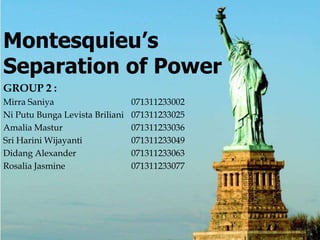Week 3, montesquieu's separation of power
- 1. Page 1 Montesquieu’s Separation of Power GROUP 2 : Mirra Saniya 071311233002 Ni Putu Bunga Levista Briliani 071311233025 Amalia Mastur 071311233036 Sri Harini Wijayanti 071311233049 Didang Alexander 071311233063 Rosalia Jasmine 071311233077
- 2. Page 2 People Behind the Ideas Clement Walker, member of Long Parliament of 1648 founded the idea of governmental separation. Marchamont Nedham, writing under the Cromwell’s Protectorate in 1656 stated that the separation between executive and legislative power was needed. John Trenchard, on 1698 argued that separation of power need separation of persons; representatives served as check and balance between the governmental organs. Montesquieu, published Spirit of Laws in 1748, stated the idea of Separation of Power.
- 3. Page 3 Who is Montesquieu? Montesquieu was originally born as Charles-Louis de Secondat, but later inherited the title Baron de Montesquieu after the death of his uncle in 1716). His name became Charles-Louis de Secondat, baron de La Brède et de Montesquieu. Established the ideas of ‘trias politica’ or ‘separation of power’ in his famous publication ‘Spirit of the Laws’ which later inspired the Declaration of the Rights of Man and the Constitution of United States.
- 4. Page 4 The Spirit of Laws (1748) Introduced 3 new convictions : Montesquieu classified the governmental form into three types: republican, monarchies, and despotisms based on each administration's principles. Montesquieu introduced the political influence of climate and of environment in general. Montesquieu talked about The Separation of Power.
- 5. Page 5 The Separation of Power The division of governmental system into the distinct branch to limit their functions of running the governmental works and to prevent the concentration of power. Separation of Power Legislative Branch Executive Branch Judicial Branch
- 6. Page 6 A. The Legislative Composed of the House and Senate. Responsible for enacting the laws of the state and count how much money needeed to operate the government. Abble to asses all federal laws; establish all lower federal courts; can override a Presidential veto; can impeach the President.
- 7. Page 7 B. The Executive Composed of the President, Vice-President, and the Departments. Responsible implementing and administering the public policy enacted by the legislative branch. Able to veto power over all bills; appointment of judges and other officials; make treaties; ensure all laws are carried out; commander in chief of the military; pardon power.
- 8. Page 8 C. The Judicial Composed of the federal courts and the Supreme Court. Responsible for interpreting the constitutions and laws and applying those to controversies brought before it. Has the power to try federal cases and interpret the laws of the nation in those cases; the power to declare any law or executive act unconstitutional.
- 9. Page 9
- 10. Page 10

